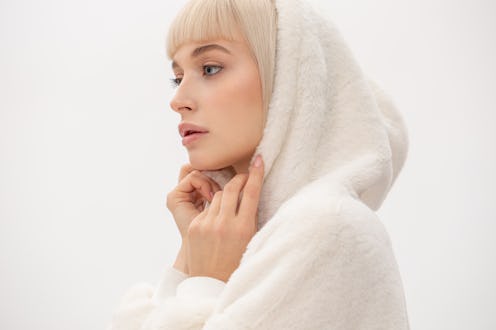(Treatments)
Reverse The Effects Of Winter Weather With These Skin Treatments
Say goodbye to dryness for good.

Each season has its pros and cons. Typically, spring and summer bring excitement of warm, sun-filled days. Similarly, fall is beloved for its crisp mornings and earthy color palettes. Winter is the one outlier. The frigid air and intense winds aren’t as welcoming — and neither are the onslaught of skin issues they bring. When it comes to combating the cold at home, products can only do so much. A hydrating routine packed with rich moisturizers and serums is a great starting point. However, investing in winter skin treatments can be more beneficial for fighting the concerns of the season.
For many, dryness tops the list during this time of year. “Fluctuating temperatures, such as central heating indoors, the cold weather outside, and hot showers are the perfect trifecta for moisture loss,” says Dr. Rina Weimann, M.D., board-certified dermatologist at Schweiger Dermatology Group in King of Prussia, PA. But that’s just the tip of the iceberg. According to Dr. Weimann, dry skin often leads to other issues like redness, flaking, and even breakouts. Treating these concerns on your own can be effective. But pairing your routines with a professional treatment can deliver greater results and improve your skin’s health.
Below, TZR tapped two dermatologists to find out the best treatments to receive, plus insight into how they can prevent common concerns during this time of year.
Acne
While acne knows no season, breakouts can occur more frequently during winter. Dr. Weimann explains that a lack of moisture causes the oil glands to work overtime. The idea is to combat dryness, but excess sebum can also trigger cystic acne flare-ups.
Microdermabrasion
If you’ve noticed an increase in breakouts deep into winter, Dr. Weimann says that microdermabrasion can help. The minimally invasive procedure is known for resurfacing the skin to give it a nice glow, but it’s also ideal for acne. As a form of exfoliation, it manually removes dead cells and unwanted debris, which can cause certain types of acne. According to Dr. Weimann, “Comedonal breakouts, such as blackheads and whiteheads, may be triggered by skin pores blocked with oil.”
Aside from ridding the skin of buildup, microdermabrasion can also increase the absorption rate of key ingredients. “With the top layer of skin removed, topical products and serums can penetrate deeper and be more effective,” she says.
Dehydrated Skin
Dryness is arguably the most common concern during the colder months. While it can lead to other issues, it has its own levels of discomfort. The decrease in humidity outside often causes the skin to become easily cracked and irritated. To combat this, you should first adapt your typical daily routine and consider a hydrating facial for an extra boost.
HydraFacial
The cold air outside is just one factor that contributes to dryness during this time of year. Protecting your face from the elements when you’re out and about is important, but the increased use of indoor heat can also wreak havoc on your skin. However, according to Dr. Marina Peredo, M.D., board-certified dermatologist and founder of Skinfluence, fluctuating temperatures can do a lot more harm. “Dryness affects your protective barrier, decreasing its ability and leading to irritation and sensitivity,” she says.
Treating this pesky issue is a daily task that begins with the products in your routine. “You should be including a thicker moisturizer or creams with ceramides that will help hydrate and soothe your skin,” she says. Along with your seasonal product swaps, she mentions that a HydraFacial can provide a much-needed boost. The treatment effectively deep cleans your skin and then hydrates it with customizable serums. Dr. Peredo also notes that it can be used on the lips to combat chapping.
Dull Complexion
Maintaining a glowing complexion during the cold is particularly challenging. Since your skin is more prone to water loss, it can begin to look dull. Blustering winds and dry air from indoor heaters can aggravate the issue even more, often resulting in a lackluster appearance.
Chemical Peels
Exfoliation is essential for reviving your skin’s radiance. While there are several methods, including face scrubs and the aforementioned microdermabrasion, chemical peels are another effective option. At its core, the treatment sloughs off dead skin cells and removes the surface layer to reveal a more youthful appearance. With dryness at an all-time high, winter is the perfect time to get one.
The key, as Dr. Weimann notes, is to select a gentle version. She explains that the purpose of a chemical peel varies based on the ingredients within the treatment. In that vein, opting for a mild one that will resurface without being too harsh can be beneficial. “Peels that contain glycolic acid may be more favorable than stronger or medium-depth peels, as this may worsen dryness and irritate the skin,” she says. Exfoliating peels also promote healthy cell turnover and in turn, improve the skin’s texture and complexion.
It’s important to remember that the glowing results from peels aren’t immediate. Typically, it takes two to three weeks to see the full effects. In the days following your treatment, you’ll notice the outer most layer of your skin begin to shed. Though you can receive several light peels in a month, Dr. Weimann recommends discussing the frequency with your dermatologist to ensure it benefits your specific skin concerns.
Despite the bitter cold, supporting your skin through winter isn’t impossible. With the right combination of at-home products and in-office treatments, you can ensure it’s protected all season long.